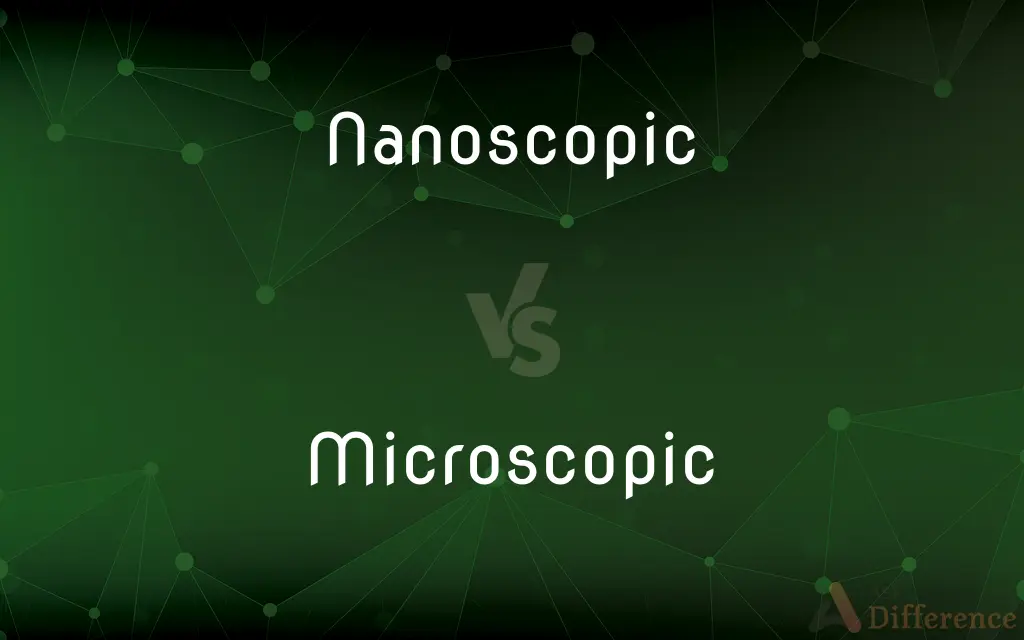Nanoscopic vs. Microscopic — What's the Difference?
By Maham Liaqat & Fiza Rafique — Updated on April 16, 2024
Nanoscopic refers to objects visible at the nanometer scale (below 100 nanometers), focusing on atomic and molecular detail, whereas microscopic pertains to objects visible at the micrometer scale (1 micrometer to 1 millimeter), focusing on cells.

Difference Between Nanoscopic and Microscopic
Table of Contents
ADVERTISEMENT
Key Differences
Nanoscopic scale refers to dimensions and phenomena that occur at 1 to 100 nanometers, emphasizing atomic and molecular structures, such as nanoparticles or the arrangement of atoms in a crystal. In contrast, microscopic scale deals with objects that are between 1 micrometer and 1 millimeter, typically involving cells, bacteria, and microscopic textures of materials.
When viewing through a nanoscope, often in the form of an electron microscope, one can observe details far beyond the cellular level, accessing the realms of individual atoms and molecules. Microscopes, such as light microscopes, are limited to cellular-level details and cannot resolve individual atoms or molecules.
The applications of nanoscopic technologies are often in the fields of nanotechnology, materials science, and molecular biology, where precise manipulation and observation at the atomic level are crucial. Microscopic techniques are widely used in medical science, biology, and environmental science to study organism structures, cell behavior, and microorganisms.
The principles of imaging differ significantly; nanoscopic imaging may use electron beams or scanning probes that interact with the surface of a sample at the atomic level, whereas microscopic imaging typically uses light waves or UV light to illuminate and magnify objects.
The shift from microscopic to nanoscopic observation marks a transition from viewing life predominantly at the cellular or organism level to understanding and manipulating the fundamental building blocks of nature itself.
ADVERTISEMENT
Comparison Chart
Scale
1 to 100 nanometers
1 micrometer to 1 millimeter
Visibility
Atoms, molecules
Cells, bacteria, microscopic fibers
Common Instruments
Electron microscopes, scanning probe microscopes
Light microscopes, fluorescence microscopes
Fields of Use
Nanotechnology, molecular biology
Biology, medical science
Detail Level
Atomic and molecular level
Cellular level
Compare with Definitions
Nanoscopic
Relating to or occurring on a scale of nanometers.
Nanoscopic imaging techniques have revolutionized our ability to see beyond the cellular level.
Microscopic
Involving the use of a microscope for observation or research.
She spent hours in the lab conducting microscopic studies.
Nanoscopic
Used to describe the detailed structure of materials at the nano-level.
Nanoscopic examination revealed the material's unique lattice structure.
Microscopic
Used in various scientific fields that study small-scale biological processes.
Microscopic techniques are essential for modern biological research.
Nanoscopic
Pertaining to the study of extremely small things not visible with a light microscope.
The chemist specialized in nanoscopic particles that behave differently than their larger counterparts.
Microscopic
Extremely small or minute, often requiring magnification to be seen clearly.
The crack in the gemstone was microscopic and not visible to the naked eye.
Nanoscopic
Involving manipulation of materials at the atomic or molecular scale.
Nanoscopic engineering involves precise positioning of individual atoms.
Microscopic
Of, relating to, or visible only by means of a microscope.
Microscopic examination is necessary to identify these bacteria.
Nanoscopic
Associated with advanced technologies in physics and engineering.
Nanoscopic devices are critical components in the latest electronic chips.
Microscopic
Pertaining to detailed visual or structural analysis at the micro-level.
The tissue samples underwent microscopic analysis for signs of disease.
Nanoscopic
Being at a scale so small that the behavior of individual atoms dominates the properties of a material or phenomenon; smaller than a micron and larger than an atom.
Microscopic
Too small to be seen by the unaided eye but large enough to be studied under a microscope.
Nanoscopic
Having a scale expressed in nanometers.
Microscopic
Of, relating to, or concerned with a microscope.
Microscopic
Exceedingly small; minute
"The activities of men ... were reduced to a microscopic scale" (John Hersey).
Microscopic
Characterized by or done with extreme attention to detail
A microscopic investigation.
Microscopic
Of, or relating to microscopes or microscopy; microscopal
We supply all microscopic stains and other materials.
Microscopic
So small that it can only be seen using a microscope.
The water was full of microscopic organisms.
Microscopic
Very small; minute
Compared to the galaxy, we are microscopic in scale.
Microscopic
(figurative) Carried out with great attention to detail.
The police carried out a microscopic search of the crime scene.
Microscopic
Able to see extremely minute objects.
Microscopic
Of or pertaining to the microscope or to microscopy; made with a microscope; as, microscopic observation.
Microscopic
Able to see extremely minute objects.
Why has not man a microscopic eye?
Microscopic
Very small.
Microscopic
Of or relating to or used in microscopy;
Microscopic analysis
Microscopical examination
Microscopic
Too small to be seen except under a microscope
Microscopic
Extremely precise with great attention to details;
Examined it with microscopic care
Microscopic
Infinitely or immeasurably small;
Two minute whiplike threads of protoplasm
Reduced to a microscopic scale
Common Curiosities
Are there specific microscopes for nanoscopic viewing?
Yes, specific instruments like electron microscopes or scanning probe microscopes are used for nanoscopic viewing.
What practical applications does microscopic technology have?
Microscopic technology has wide applications in medical diagnostics, environmental science, and academic research, among others.
What is the main difference between nanoscopic and microscopic scales?
The main difference lies in the size of the objects observed; nanoscopic scale focuses on atomic and molecular details, whereas microscopic scale typically involves cellular and larger structures.
Can nanoscopic methods see viruses?
Yes, nanoscopic methods like electron microscopy can visualize viruses, which are smaller than most cells but larger than many molecules.
What advancements have been made in nanoscopic technology?
Significant advancements in nanoscopic technology include the development of high-resolution electron microscopes and atomic force microscopes.
Can microscopic techniques identify chemical compositions?
While basic microscopic techniques focus on visual observation, techniques like spectroscopy coupled with microscopy can analyze chemical compositions.
What skills are necessary for nanoscopic research?
Skills in physics, chemistry, and precision engineering are crucial for conducting nanoscopic research.
How does microscopic imaging work?
Microscopic imaging often uses light to illuminate and lenses to magnify objects to make them visible.
Is there a crossover between nanoscopic and microscopic technologies?
Yes, developments in both fields often benefit one another, especially in areas like material science and biomedical engineering.
How small is a nanometer compared to a micrometer?
A nanometer is a thousand times smaller than a micrometer.
How has microscopy evolved over the years?
Microscopy has evolved from simple light-based systems to complex systems incorporating digital technologies and advanced imaging techniques.
What are the limitations of microscopic and nanoscopic techniques?
Limitations include resolution limits for light microscopes due to wavelength, and the complex preparation and high costs associated with nanoscopic imaging.
Are nanoscopic and microscopic techniques used together?
Yes, these techniques can be complementary, especially in interdisciplinary research combining molecular and cellular perspectives.
Can microscopic observations be automated?
Yes, modern microscopic systems often include automated stages and imaging processes for high-throughput analysis.
Why is nanoscopic technology important?
Nanoscopic technology is crucial for advancements in electronics, pharmaceuticals, and materials engineering, enabling us to manipulate materials at the most fundamental levels.
Share Your Discovery

Previous Comparison
Margarine vs. Oleo
Next Comparison
Inarguably vs. ArguablyAuthor Spotlight
Written by
Maham LiaqatCo-written by
Fiza RafiqueFiza Rafique is a skilled content writer at AskDifference.com, where she meticulously refines and enhances written pieces. Drawing from her vast editorial expertise, Fiza ensures clarity, accuracy, and precision in every article. Passionate about language, she continually seeks to elevate the quality of content for readers worldwide.















































